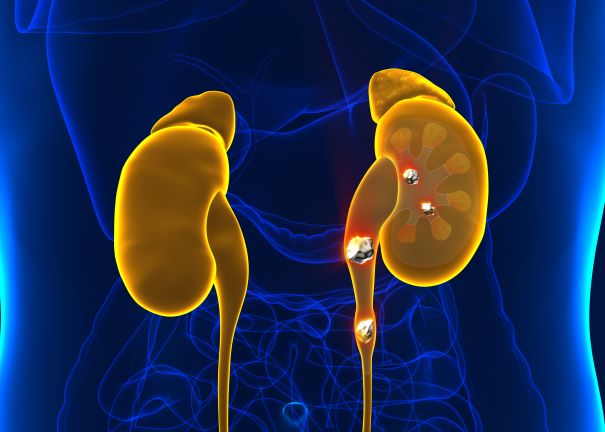What is ureteroscopy, and how does it help treat kidney stones?

Your kidneys are a matching pair of bean-shaped organs that face one another on either side of your spine, snuggled just under the protection of your ribcage. Each serves as a powerful filtration machine for your body. As blood circulates through each kidney, about a million filtering units draw out excess water, salts and minerals, as well as waste products and toxins. The filtered blood returns to your body with its healthy balance restored, while the excess fluid, waste and toxins drain out of your kidney as urine, running through a tube called the ureter down into your bladder.
Though your kidneys work around the clock to filter about 150 quarts of blood each day, they don’t normally attract your attention. However, if you’re one of the roughly 10% of Americans who develop a kidney stone, the sudden pain will make you take instant notice.
What causes kidney stones?
Usually, urine contains enough liquid to flush all the minerals and waste products out of your body. But when these substances become too concentrated (for example, if you don’t drink enough water, have a urinary tract blockage or take calcium-based antacids for an extended time), they can stick together, forming a solid mass of crystals. Small stones will often pass through the body on their own, though rarely without noticable discomfort. Larger stones, however, can get stuck somewhere along the path – in your kidney, ureter, bladder or urinary tract – blocking the flow of urine and triggering severe pain.
That’s when your doctor will want to discuss ways to remove your kidney stones. Your treatment depends on the type and size of your stone, its location in your body and your symptoms.
-
For small stones, your doctor may recommend non-invasive shock wave lithotripsy, which uses high-energy waves to break the stone into smaller pieces that your body might then naturally flush out.
-
For very large or complex stones, your doctor may recommend a surgical retrieval method called percutaneous nephrolithotomy (PCLN), performed through an incision in your back.
-
For stones that fall in between those two sizes, your doctor may recommend a ureteroscopy, a minimally invasive surgical procedure that breaks apart the stone and retrieves it from your body.
Ureteroscopy: kidney stone treatment through a tube
There are no surgical cuts or incisions made in a ureteroscopy. Rather, after you are under anesthesia, a urologist inserts a flexible, telescope-like instrument, called a ureteroscope, through the opening of your urinary tract and up into the bladder. This scope is used like a camera to examine your urinary tract, locate the kidney stone and then treat it with a variety of tools that can be passed through the scope’s slender shaft.
When your kidney stone is in sight, your doctor extends a tool that breaks up the stone into smaller pieces using pulses of laser energy. The smaller stones are then collected with a basket tool that slides up through the device shaft and unfolds from the tip of the scope. Your doctor may also use the scope to then insert a small plastic tube, called a ureteral stent, into your urinary tract to help with healing and urine drainage after the procedure. (It’s removed at a follow-up appointment.)
Reducing complications from kidney stones
During ureteroscopy, fluid irrigation may be used to maintain a clear visual field. However, this irrigation can lead to elevated pressure inside the kidneys, called high intrarenal pressure (IRP), which may contribute to post-op complications like pain, renal damage, infection and sepsis. The challenge: urologists did not have a convenient means to measure IRP levels in real time during the procedure – knowledge that could help them know when pressure levels needed to be reduced. R&D engineers at Boston Scientific took notice of this unmet need.
“We already had a well-established single-use ureteroscope system in our portfolio that urologists use and trust,” says Meghan Scanlon, president of urology at Boston Scientific. “Based on the needs we were hearing from urologists, our R&D team explored whether we could build pressure sensing directly into the next generation of that device – an incredibly complex task, but one we felt would give physicians meaningful insight when treating their patients.”
Enter the LithoVue™ Elite Single-Use Digital Flexible Ureteroscope System, which just received regulatory clearance from the U.S. Food and Drug Administration (FDA) last month, following earlier clearances in Australia, Japan and Canada. The first commercialized ureteroscope that measures intrarenal pressure, the LithoVue Elite System is the newest iteration of the LithoVue™ Single-Use Digital Flexible Ureteroscope product family, which Boston Scientific launched in 2016 to help address operational challenges and costs associated with widely used reusable scopes that require maintenance, sterilization and reprocessing.
“This new ability to monitor intrarenal pressure from one second to the next, is designed to give urologists a level of knowledge, decision making and functionality they’ve never had before,” says Scanlon. “We’re excited to offer products aimed at making procedures more efficient and, importantly, help optimize patient care.”
To learn more about kidney stone causes, risk factors and treatment options, visit My Kidney Stone.